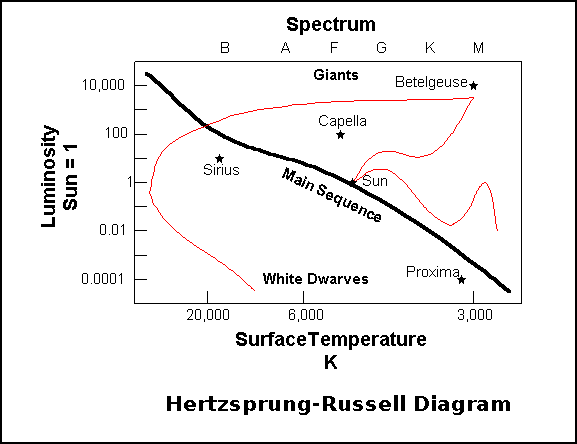This page last modified 1998 July 19
Stellar Evolution
Stars and the Hertzsprung-Russell Diagram
Stars are considered to be massive balls of hydrogen which emit heat and light as a consequence of nuclear fusion of the hydrogen to helium. They can be analysed by spectroscopy -- the element Helium was first identified by spectrographic analysis of the Sun. The spectrographic classification of stars used to day is based on that devised by Annie Jump Cannon (1863-1941); it depends on the colour of the star which, in turn, depends upon its surface temperature. Cannon classified over 450,000 stars in this manner. Each spectral type is assigned a letter:
| Letter | Surface Temperature (K) |
Colour | Spectral Characteristics | |||
| W | > 40,000 | White or bluish | Many emission lines | |||
| O | 30,000 | White or bluish | Emission and absorption lines | |||
| B | 20,000 | Bluish | He and H dominant | |||
| A | 10,000 | White | H dominant | |||
| F | 7,000 | Yellowish | Ca dominant | |||
| G | 6,000 | Yellow | Many metals present | |||
| K | 4,000 | Orange | Very strong metallic lines | |||
| M | 3,000 | Reddish-orange | Complicated owing to presence of molecules | |||
| R | 2,600 | Red | C dominant | |||
| N | 2,500 | Red | C dominant | |||
| S | 2,600 | Red | ZiO and TiO dominant |
R and N are often now combined to give one class, C.
Classes W, R, N and S are extremely rare.
Early in the 20th Century the work of the astronomers Ejnar Hertzsprung and Henry Norris Russell led to the construction of what are now known as Hertzsprung-Russell (H-R) Diagrams, in which a star's absolute luminosity is plotted against its surface temperature (or spectral type).

Most stars fall on a narrow band known as the Main Sequence (NB -- this is not an evolutionary sequence! A typical evolutionary sequence is shown by the red curve).
Stars range in mass from about 0.08 to 100 solar masses (1 solar mass = mass of Sun), but most have masses similar to or less than that of the Sun. Masses grater than 10 solar masses are rare. However, the range of densities is very great. Red Giants, such as Betelgeuse, are less dense than the air we breathe, whereas a sugar- lump size of white dwarf material would, on Earth, weigh in excess of 1 tonne.
Stellar Evolution
Stars begin by condensing out of nebular material. As it collapses under the force of gravity it becomes hotter. If the initial mass is between about 0.1 and 1.4 solar masses, the core temperature will rise to about 10,000,000K and nuclear reactions will start, converting H to He. The star becomes a main sequence star. Eventually the H will be exhausted and gravity causes further shrinkage; more reactions occur and heavier elements are formed. These accumulate in the core, which collapses as the outer layers expand -- the star leaves the main sequence and becomes a giant. The core temperature may rise and the outer layers may be thrown off into space as a planetary nebula. The nuclear reactions eventually stop and all that remains of the original star, i.e. the core, is inert -- a White Dwarf has formed.
Pulsars
If the initial mass is between about 1.4 and 8 solar masses, everything happens more quickly. When the stage of heavy element formation is reached, the core temperature rises to around 3,000,000,000K. The core is now made of iron, which will not react. As the reactions cease, the core implodes; this is followed by a rebound explosion: a Supernova. Most of the material is hurled into space, leaving a cloud of expanding gas at the centre of which is a small (a few km in diameter), super-dense (about 1,000,000,000,000,000 tonnes per cm3) object made of neutrons. This neutron star spins very rapidly, often many times a second. It has a very powerful magnetic field which gives direction to the radio pulses emitted by the star, rather like a lighthouse. The first pulsar (pulsating radio source) was discovered in 1967 by Jocelyn Bell. The pulsar in the Crab Nebula, M1, in Taurus is the remnant of the supernova of AD1054 which, for a while, was so bright as to be visible in the daytime sky. Pulsars gradually slow down and become cold and dead.
Black Holes and Quasars
If the initial mass exceeds about 8 solar masses, the implosion does not result in a supernova, but the star keeps collapsing, becoming denser and denser. As it does so, the escape velocity increases until it reaches the speed of light (300,000 km s-1). At this stage nothing, not even light, can escape -- a black hole has formed. Some sources of radio noise did not appear to be related to any optical star or galaxy. In 1963 Cyril Hazard identified the location of a radio source known as 3C 273 (No. 273 in the 3rd Cambridge catalogue) when it was occulted by the Moon. It was identified with a star-like object with great redshift (see later), indicating that it was at a great distance. More recent studies have confirmed that quasars (quasi-stellar objects, QSO's) lie at the hearts of galaxies which are themselves too dim to be visible. Most quasars are not radio sources. Quasars are thought to be of the order of size of out solar system, but radiate more than 1000 times as much energy as our entire galaxy. The current explanation is that they result from a supermassive black hole which is consuming matter from its surrounding galaxy at the rate of about 1 solar mass per year.
Binary Stars
Many stars exist in multiple (usually binary) systems in which the stars orbit each other in accordance with Kepler's Laws. They are of importance in astrophysics because analysis of their orbits is the only way to directly determine stellar masses.
Novae
When a white dwarf and a red giant form a binary system, material flows from the red giant to the white dwarf, forming an accretion disc around it. When sufficient material has built up, it undergoes nuclear fusion and an explosive outburst occurs, during which the star flares up brightly. The process then repeats (e.g. T Coronae Borealis went nova in 1866 and 1946). (For dwarf novae, see under cataclysmic variables)
References
The classic book on stellar evolution is Martin Schwarzschild's Structure and Evolution of the Stars. This is a university level text; those who might prefer something simpler could look at the appropriate parts of John Gribbin's Companion to the Cosmos, which is an excellent guide, arranged alphabetically and is thoroughly worth getting.


